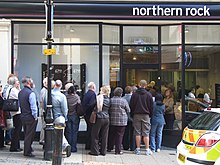
Back ارتجاع إيجابي Arabic Retroalimentació positiva Catalan پەرچەپێدانەوەی ئەرێنی CKB Positiv tilbagekobling Danish Positive Rückkopplung German Realimentación positiva Spanish Atzeraeragin positibo EU بازخورد مثبت FA Rétroaction French Retroalimentación positiva GL


Positive feedback (exacerbating feedback, self-reinforcing feedback) is a process that occurs in a feedback loop which exacerbates the effects of a small disturbance. That is, the effects of a perturbation on a system include an increase in the magnitude of the perturbation.[1] That is, A produces more of B which in turn produces more of A.[2] In contrast, a system in which the results of a change act to reduce or counteract it has negative feedback.[1][3] Both concepts play an important role in science and engineering, including biology, chemistry, and cybernetics.
Mathematically, positive feedback is defined as a positive loop gain around a closed loop of cause and effect.[1][3] That is, positive feedback is in phase with the input, in the sense that it adds to make the input larger.[4][5] Positive feedback tends to cause system instability. When the loop gain is positive and above 1, there will typically be exponential growth, increasing oscillations, chaotic behavior or other divergences from equilibrium.[3] System parameters will typically accelerate towards extreme values, which may damage or destroy the system, or may end with the system latched into a new stable state. Positive feedback may be controlled by signals in the system being filtered, damped, or limited, or it can be cancelled or reduced by adding negative feedback.
Positive feedback is used in digital electronics to force voltages away from intermediate voltages into '0' and '1' states. On the other hand, thermal runaway is a type of positive feedback that can destroy semiconductor junctions. Positive feedback in chemical reactions can increase the rate of reactions, and in some cases can lead to explosions. Positive feedback in mechanical design causes tipping-point, or over-centre, mechanisms to snap into position, for example in switches and locking pliers. Out of control, it can cause bridges to collapse. Positive feedback in economic systems can cause boom-then-bust cycles. A familiar example of positive feedback is the loud squealing or howling sound produced by audio feedback in public address systems: the microphone picks up sound from its own loudspeakers, amplifies it, and sends it through the speakers again.

- ^ a b c Ben Zuckerman & David Jefferson (1996). Human Population and the Environmental Crisis. Jones & Bartlett Learning. p. 42. ISBN 9780867209662. Archived from the original on 2018-01-06.
- ^ Keesing, R.M. (1981). Cultural anthropology: A contemporary perspective (2nd ed.) p.149. Sydney: Holt, Rinehard & Winston, Inc.
- ^ a b c
Bernard P. Zeigler; Herbert Praehofer; Tag Gon Kim Section (2000). "3.3.2 Feedback in continuous systems". Theory of Modeling and Simulation: Integrating Discrete Event and Continuous Complex Dynamic Systems. Academic Press. p. 55. ISBN 9780127784557. Archived from the original on 2017-01-03.
A positive feedback loop is one with an even number of negative influences [around the loop].
- ^ S W Amos; R W Amos (2002). Newnes Dictionary of Electronics (4th ed.). Newnes. p. 247. ISBN 9780750656429. Archived from the original on 2017-03-29.
- ^ Rudolf F. Graf (1999). Modern Dictionary of Electronics (7th ed.). Newnes. p. 276. ISBN 9780750698665. Archived from the original on 2017-03-29.